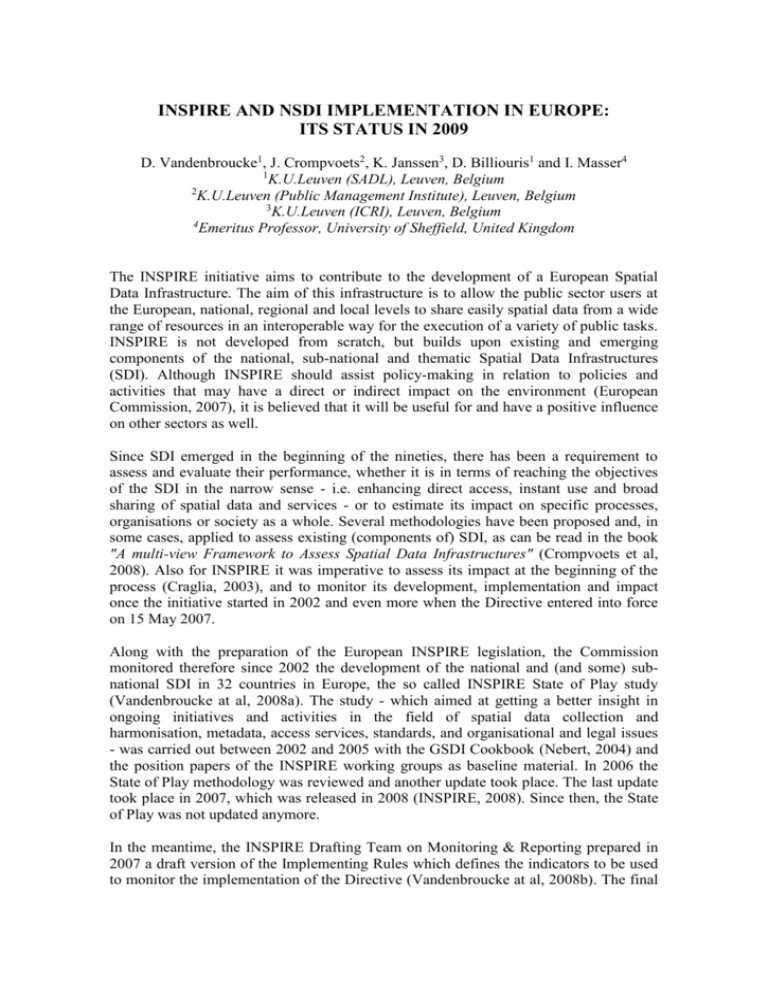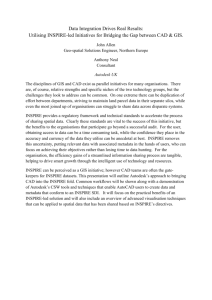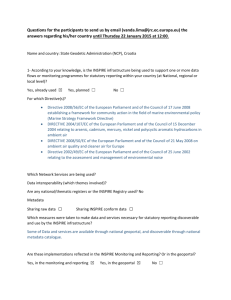Abstract (DOC) - inspire
advertisement

INSPIRE AND NSDI IMPLEMENTATION IN EUROPE: ITS STATUS IN 2009 D. Vandenbroucke1, J. Crompvoets2, K. Janssen3, D. Billiouris1 and I. Masser4 1 K.U.Leuven (SADL), Leuven, Belgium 2 K.U.Leuven (Public Management Institute), Leuven, Belgium 3 K.U.Leuven (ICRI), Leuven, Belgium 4 Emeritus Professor, University of Sheffield, United Kingdom The INSPIRE initiative aims to contribute to the development of a European Spatial Data Infrastructure. The aim of this infrastructure is to allow the public sector users at the European, national, regional and local levels to share easily spatial data from a wide range of resources in an interoperable way for the execution of a variety of public tasks. INSPIRE is not developed from scratch, but builds upon existing and emerging components of the national, sub-national and thematic Spatial Data Infrastructures (SDI). Although INSPIRE should assist policy-making in relation to policies and activities that may have a direct or indirect impact on the environment (European Commission, 2007), it is believed that it will be useful for and have a positive influence on other sectors as well. Since SDI emerged in the beginning of the nineties, there has been a requirement to assess and evaluate their performance, whether it is in terms of reaching the objectives of the SDI in the narrow sense - i.e. enhancing direct access, instant use and broad sharing of spatial data and services - or to estimate its impact on specific processes, organisations or society as a whole. Several methodologies have been proposed and, in some cases, applied to assess existing (components of) SDI, as can be read in the book "A multi-view Framework to Assess Spatial Data Infrastructures" (Crompvoets et al, 2008). Also for INSPIRE it was imperative to assess its impact at the beginning of the process (Craglia, 2003), and to monitor its development, implementation and impact once the initiative started in 2002 and even more when the Directive entered into force on 15 May 2007. Along with the preparation of the European INSPIRE legislation, the Commission monitored therefore since 2002 the development of the national and (and some) subnational SDI in 32 countries in Europe, the so called INSPIRE State of Play study (Vandenbroucke at al, 2008a). The study - which aimed at getting a better insight in ongoing initiatives and activities in the field of spatial data collection and harmonisation, metadata, access services, standards, and organisational and legal issues - was carried out between 2002 and 2005 with the GSDI Cookbook (Nebert, 2004) and the position papers of the INSPIRE working groups as baseline material. In 2006 the State of Play methodology was reviewed and another update took place. The last update took place in 2007, which was released in 2008 (INSPIRE, 2008). Since then, the State of Play was not updated anymore. In the meantime, the INSPIRE Drafting Team on Monitoring & Reporting prepared in 2007 a draft version of the Implementing Rules which defines the indicators to be used to monitor the implementation of the Directive (Vandenbroucke at al, 2008b). The final implementing rules were voted by the INSPIRE committee in December 2008 and published as Commission Decision 2009/443/EC on 5 June 2009. Since then Member States are legally bound to monitor the implementation of INSPIRE through the calculation and publication of 8 indicators, and to prepare a 3-yearly report with more quantitative and qualitative information including information on the use of the INSPIRE infrastructure, examples of costs and benefits, how stakeholders collaborate, the way coordination is done, etc. In March 2009, the European Commission launched a new "INSPIRE & NSDI implementation, State of Play" study. Although the two processes - the INSPIRE State of Play and the Implementing Rules for monitoring and reporting - are not the same, one can wonder why a new State of Play is necessary if Member States have the legal obligation to monitor and report INSPIRE implementation? There are mainly three reasons for that. First of all, the INSPIRE & NSDI State of Play collects additional information that is not required according to INSPIRE obligations: e.g. information on NSDI components beyond the scope of INSPIRE; information regarding related legislation; etc. Secondly, the INSPIRE & NSDI State of Play will not only collect and structure this additional information, but also analyse the information at the European level, derive some ‘lessons learnt’ (good practices) and give recommendations for further implementation of INSPIRE and NSDI. Finally, the INSPIRE & NSDI State of Play is analyzing 34 countries in Europe (from 2009 onwards also Croatia and FYROM are included), 7 more than the 27 Member States. The objectives of the renewed INSPIRE & NSDI State of Play are threefold: 1) To finetune the methodology used in previous State of the Play Studies in order to bring it more in line with the development of INSPIRE and the latest work carried out by the INSPIRE drafting teams; 2) To prepare an annual State of Play study for two consecutive years, based on the work done in the previous State of the Play studies; and 3) To carry out an in depth study of specific aspects that have emerged as being important within the development of INSPIRE, going beyond legal compliance, to better grasp some key issues on successful implementation and best practice (also during two consecutive years). The methodology to assess the NSDI and INSPIRE implementation was reviewed during a one-day workshop in May 2009. At the same time, collection of new information began through the analysis of key documents, screening of geo-portals, etc., and a detailed survey was prepared. The detailed survey for the year 2009-2010 took place between November 2009 and February 2010. Its focus is on different aspects related to the implementation of INSPIRE: coordination, funding and sharing measures. The survey relate to five important topics of INSPIRE implementation. First, the analysis of the status of INSPIRE transposition, including the problems encountered during this phase and the link with other (existing) legislation. Second, the assessment of the existence or absence of an implementation strategy, including the organisations involved. This topic also covers the funding of INSPIRE. The third topic of the survey focuses on coordination and cooperation aspects. It tries to answer questions like: "Has a specific coordinating structure (body) been created", "What is its composition", "How many and which stakeholders are involved", etc. Particular attention is paid to the potential impact on the structure of existing organisations and the way they work. The fourth topic relates to the measures taken to improve data and service sharing and the way access to spatial data sets falling under the 34 themes of the three annexes of the Directive is regulated. Limitations regarding public access and data sharing restrictions are part of this analysis. The status of the geo-portal, if such a portal exists, is the last topic of survey. The paper presents the current status of INSPIRE and NSDI development at the European level, analyses the results of the desktop study and the survey in detail and highlights some of the remarkable developments in Europe, with particular attention on what seems to work well and why. The paper ends with an overview of the topics which deserve particular attention at the European level in order to obtain a dynamic and well performing European SDI consisting of many national and sub-national SDI nodes. The ongoing and future work within this study is highlighted as well. Acknowledgement The INSPIRE & NSDI State of Play study is commissioned by EUROSTAT. The study is carried out by the authors and supported by a group of international experts whom we want to acknowledge for their contribution to the assessment: Mauro Salvemini (EUROGI, Sapienza University of Rome), Angela Ionita (ICIA, Romania), Arnold Bregt (University of Wageningen), Bastiaan van Loenen (T.U. Delft), Marie-Louise Zambon (IGN France), Mark Probert (Geolink Consulting), Pedro Muro-Medrano (University of Zaragoza), Christian Elfers and Kristian Senkler (con terra). References Craglia, M., 2003. Contribution to the extended impact assessment of INSPIRE, on http://www.ec-gis.org/inspire/reports/fds_report.pdf, [accessed 4 January 2008]. Crompvoets, J., Rajabifard, A., van Loenen, B., en T. Delgado Fernández (Editors), 2008. A Multi-view Framework to Assess Spatial Data Infrastructures (ISBN: 978-07325-1623-9) Melbourne University Press, Melbourne, Australia. European Commission (2007). Directive 2007/2/EC of the European Parliament and of the Council of 14 March 2007 establishing an Infrastructure for Spatial Information in the European Community (INSPIRE), L108/1. INSPIRE, http://inspire.jrc.ec.europa.eu/index.cfm/pageid/6/list/4 (accessed on 31 January 2010). Nebert, D. D. (Ed.) (2000). Developing Spatial Data Infrastructures: The SDI Cookbook, version 1.0, at http://www.gsdi.org/pubs/cookbook/Default.htm, [accessed 3 March 2008]. Vandenbroucke, D., M-L. Zambon, J. Crompvoets and H. Dufourmont, 2008a. INSPIRE Directive: Specific requirements to monitor its implementation. In Crompvoets, J., A. Rajabifard, B. van Loenen and T. Delgada (Eds.). A Multi-View Framework to Assess National Spatial Data Infrastructures (ISBN: 978-0-7325-1623-9), Melbourne University Press, Australia. Vandenbroucke, D., K. Janssen and J. Van Orshoven, 2008b. INSPIRE State of Play: Generic approach to assess NSDI. In Crompvoets, J., A. Rajabifard, B. van Loenen and T. Delgada (Eds.). A Multi-View Framework to Assess National Spatial Data Infrastructures (ISBN: 978-0-7325-1623-9), Melbourne University Press, Australia.









